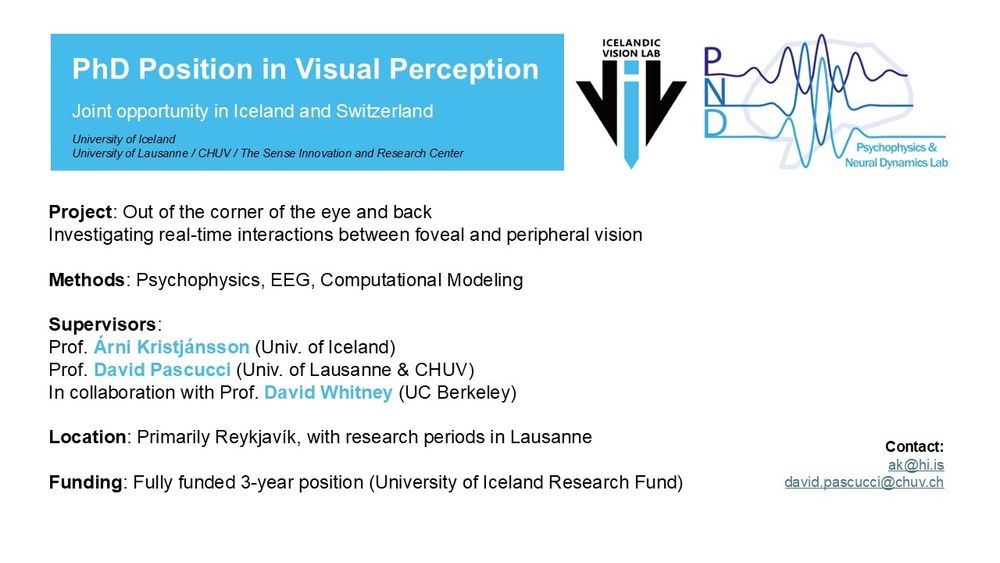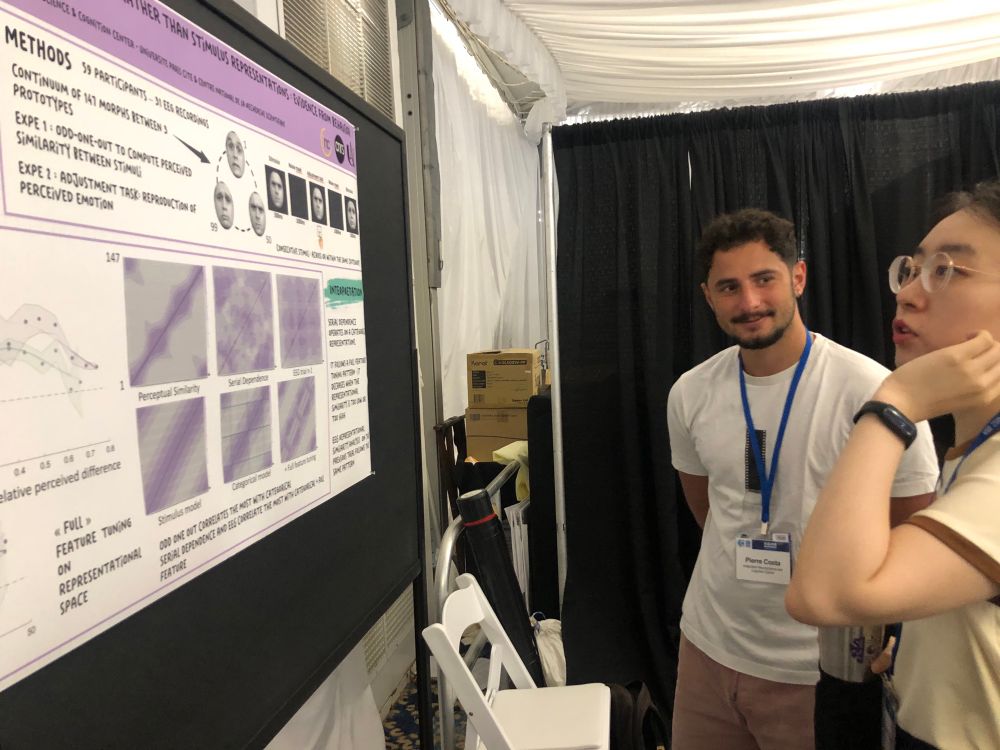
Please distribute: PhD Position in Visual Perception -- joint opportunity in Iceland and Switzerland #visionscience #cogsci #neuroskyence #psychscisky #phd #academia
27.05.2025 14:41 — 👍 25 🔁 29 💬 2 📌 1@canmertdoit.bsky.social
PhD Student at INCC Paris | Université Paris Cité Interested in visual perception, cycling, running, and cinema

Please distribute: PhD Position in Visual Perception -- joint opportunity in Iceland and Switzerland #visionscience #cogsci #neuroskyence #psychscisky #phd #academia
27.05.2025 14:41 — 👍 25 🔁 29 💬 2 📌 1
Happily graduated from my first VSS meeting with a top finish, but my poorly slept and jetlagged body disagrees...
22.05.2025 14:07 — 👍 0 🔁 0 💬 0 📌 0We only claim that the way you respond to stimulus (or the way the task is designed) seems to matter, as they lead to differences in the ways these effects are exerted (and quite intuitively tbh). Whatever those differences are need future work.
22.05.2025 14:01 — 👍 1 🔁 0 💬 0 📌 0...or they may be the same thing reflected in different ways. But this does not explain why they would show differences as a function of response type.
22.05.2025 14:01 — 👍 0 🔁 0 💬 1 📌 0...previous response in the other direction, as well as repulsion from the previous stimulus. I understand your reluctance to regard these as independent factors, and I am indifferent to that claim. There may be an overarching principle (or a mechanism) that modulates different sources of attractors
22.05.2025 14:01 — 👍 0 🔁 0 💬 1 📌 0Valid point! It is true that the effects may be confounded towards category centers. It is fortunate in our case that we see the effects across all distances to the reference (at similar magnitudes). Noisy stimuli that can be approximated to a category prototype still show attraction towards the...
22.05.2025 14:01 — 👍 0 🔁 0 💬 1 📌 0...stimulus was presented for 50 ms, indicating that they have distinct modulations. However, these explanations do not *solve* the issue. It is still possible that they are confounded, especially with continuous responses. I would be happy to have your input if you know a way around this!
19.05.2025 17:34 — 👍 1 🔁 0 💬 1 📌 0...correlation before our analysis, but we have a posteriori explanations: Responses and stimuli led to opposing effects with categorical responses, suggesting their independence. With continuous responses, it was only the repulsion from the previous stimulus that reached significance when the...
19.05.2025 17:34 — 👍 1 🔁 0 💬 2 📌 0Of course, I love questions that I can answer! Hopefully these will be among them... It is correct that we used a limited range of stimuli (±30-90) for all conditions. Subjects had to compare those orientations to a fixed one when giving categorical responses. We didn't attempt to tackle the high...
19.05.2025 17:34 — 👍 1 🔁 0 💬 2 📌 0
Serial dependence is feature-tuned to object categories
PhD candidate Pierre Costa presenting our work at #vss2025
Interested in how response types influence attractive and repulsive history effects? Come see my poster this afternoon at Banyan Breezeway summarizing this manuscript! #VSS2025
www.visionsciences.org/presentation...
It is curious what causes these differences between response types. More on that in the paper 👆
02.05.2025 16:04 — 👍 0 🔁 0 💬 0 📌 0Relative differences between successive events revealed distinct modulations for response types, suggesting that two mechanisms are at play. We also show several conditions which favor attractive or repulsive effects (again, different for each response type).
02.05.2025 16:04 — 👍 0 🔁 0 💬 1 📌 0
A diagram illustrating that previous response and stimulus exert the same effects with continuous responses and opposing effects with categorical responses.
We revealed two origins of history effects, from the previous stimulus and response. Whether they exert the same or opposing effects was determined by response type (method of adjustment vs. 2AFC).
02.05.2025 16:03 — 👍 0 🔁 0 💬 1 📌 0
Happy to share the first manuscript of my PhD (now submitted for review)!
Attractive and repulsive history effects in categorical and continuous estimates of orientation perception
doi.org/10.1101/2025...
Had a blast! Thanks to all organizers and participants who made this a memorable experience! 🥰
31.01.2025 19:26 — 👍 1 🔁 0 💬 0 📌 0Which part of the manuscript do you find the hardest to write? Maybe the first paragraph? I like it when my imagination goes wild, making connections to personal experiences, but they always end up irrelevant. How do you manage to keep things interesting and relevant?
05.01.2025 13:44 — 👍 1 🔁 0 💬 0 📌 0
How do experiment design and stimulus duration modulate attractive and repulsive history effects? We asked this in a set of experiments and might have found really interesting data. I'd like to get your input too. Come see my poster in the first session tomorrow! #ECVP2024
25.08.2024 21:19 — 👍 3 🔁 0 💬 0 📌 0Hiya! I'm here to tell the stories of my personal and academic life, to think out loud, and to make new connections with like-minded people. For now, I will be crossposting Twitter, but I'm hoping to grow into this platform eventually 🌿
10.07.2024 10:39 — 👍 12 🔁 0 💬 0 📌 1